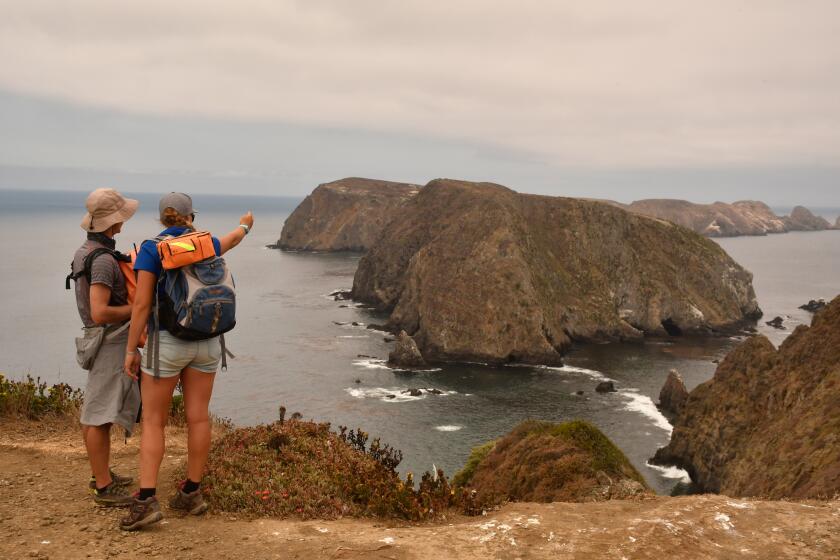Newsletter: California lawmakers put the brakes on plastics. What does it mean for the rest of us?

- Share via
Good morning, and welcome to the Essential California newsletter. It’s Friday, July 1. I’m Susanne Rust, an environment reporter domiciled in the Bay Area.
Gov. Gavin Newsom has signed into law what is arguably the nation’s most sweeping and comprehensive plastic pollution bill. Ambitious in scope and years in the making, the legislation will reduce single-use plastics and packaging across the state by focusing on reducing source production.
It calls for a 25% reduction in single-use plastics by 2032, as well as a 65% recycling rate for all plastic items sold, distributed or imported into the state by that year.
As for that pernicious foamy plastic known as expanded polystyrene — which is banned in 128 cities in California — the legislation requires a 25% recycling rate by 2025. If the producers can’t achieve that level, the plastic will be prohibited; currently, only about 6% is recycled.
“It’s a de facto ban,” Jay Ziegler, the Nature Conservancy’s director of policy and external affairs, told me when we talked about the bill this week.
I’ve been covering the legislation’s evolution for the last couple of months. It was unclear, even as recently as last week, that this bill would pass. But it did. And now it’s California law.
And though I’ve been reporting on the intricacies of the bill’s language and intent, it wasn’t until it passed the Senate on Thursday morning that I began to wonder, what now?
The legislation is clearly a big deal for plastic producers, chemical companies and the fossil fuel industry — which creates the feedstock for nearly all plastics — but what does it mean for the rest of us? When I walk into my local Safeway supermarket tomorrow, will I see a difference?
I talked to Christy Leavitt, Oceana’s plastics campaign director, to get an idea of what this law will look like to the typical Californian.
She said we shouldn’t expect to see major changes today or tomorrow. But over the next few years, we’ll see a noticeable decrease in single-use plastics and a change in how we consume our products.
“Let me first say this is a really big deal,” she said. “California is solidifying itself as an environmental leader by passing the boldest plastics source-reduction policy in the country. It will protect California’s oceans, communities and the climate and really does set the bar on plastics-reduction policies.”
Over the next few years, she said, “Californians will see less plastic packaging and foodware in grocery stores, at other stores, in restaurants and in their homes,” she said.
To be clear, she said, packaging is “the laundry detergent container, it’s the plastic shampoo bottle, it’s the plastic yogurt container, it’s the plastic that surrounds so many of the products that we use and eat on a daily basis.”
So, there’ll be less of that stuff, she said, but the bill also mandates that producers adopt a reuse and refill system. That means that rather than getting a new laundry detergent container each time you go to the store, she said, there will be “a system of reusing or refiling that laundry detergent container so that you could use the packaging more than once.”
The law is the first of its kind in the nation, she added.
“In some cases, it’s going back to what it was like for our parents or grandparents,” in which consumers buy items made from recyclable material such as glass and metal, or buy in bulk with reusable containers, she said.
The disappearance of polystyrene is likely to be the first thing consumers notice.
“California will finally ban things like plastic foam cups, plates, takeout containers,” she said. “And people will experience that.”
But the oceans, marine life and waterways will possibly be the biggest beneficiaries, as the amount of plastic escaping California’s borders drops.
And because California often influences policies in other states and nation, the law could have a multiplier effect.
[Read the story: “Newsom signs nation’s most sweeping law to phase out single-use plastics and packaging waste”]
And now, here’s what’s happening across California:
Note: Some of the sites we link to may limit the number of stories you can access without subscribing.
L.A. STORIES
It’s been one year since the Los Angeles Police Department botched the detonation of a cache of fireworks in a South Los Angeles neighborhood. Seventeen people were injured in the resulting blast, which badly damaged many homes, displacing more than 80 residents.
Many of those families were relocated to the Level Hotel, a luxury hotel in downtown L.A.
The relocation was meant to be a stopgap — a temporary shelter for families whose homes had been destroyed. But for a variety of reasons, including lawyers, legal hurdles, reluctance and the high cost of housing in Los Angeles, many have stayed.

According to Times reporters Brittny Mejia and Kevin Rector, eighteen families — 66 people — still reside at the Level. As of April, the city’s hotel bill was $1.4 million.
Mejia and Rector revisited Paula Benítez de Rodríguez and her family — four generations now stuffed into a two-bedroom hotel suite overflowing “with the accoutrements of five separate lives. The fridge is crowded with food. Oranges, onions, chiles and tomatoes are stored in teal and white bowls on the kitchen floor. The women take turns cooking in the cramped space. Sometimes they stack dirty dishes out on the balcony to free up space.”
“Everyone is piled on top of each other,” Benítez de Rodríguez told the reporters. “From day to night, I lost everything. I lived there, had my business there. How could I lose everything?” Los Angeles Times
Our daily news podcast
If you’re a fan of this newsletter, you’ll love our daily podcast “The Times,” hosted every weekday by columnist Gustavo Arellano, along with reporters from across our newsroom. Go beyond the headlines. Download and listen on our App, subscribe on Apple Podcasts and follow on Spotify.
POLITICS AND GOVERNMENT
California cut ties with a foundation that provided healthcare for more than 700 HIV-positive patients in Los Angeles. The reason? Improper negotiating tactics.
The state says the AIDS Healthcare Foundation — a nonprofit with considerable power in Sacramento — sent letters to its enrollees informing them it would no longer be providing their care, stoking fear among the patients. The letters were sent during negotiations over how much money California would pay the foundation per enrollee.
At the time the letters were sent, the state had no plans to end the contract, The Times’ Melody Gutierrez reports.
The foundation and its founder, Michael Weinstein, are a political force in California. The group has bankrolled rent-control measures statewide, challenged Los Angeles planning decisions and pushed statewide initiatives to lower prescription drug costs and require porn actors to wear condoms.
The state said it will assist patients in transitioning to other plans and maintaining their continuity of care. Los Angeles Times
Californians have been talking about high-speed rail and bullet trains for years — and there’s little to show for it. But late Wednesday night, the Legislature approved a plan to release money for a bullet train in the Central Valley, establish an inspector general to audit the project and authorize billions of dollars to be spent on new rail plans across the state.
The plan — which was included in a budget trailer bill — effectively ends a year of deadlock on how to spend the $4.2 billion in bond funds for the train.
Newsom wanted to use the money for a Central Valley route, connecting Bakersfield and Merced with 171 miles of high-speed rail. But leading Democrats wanted to spend the funds closer to urban centers, infusing beleaguered commuter systems such as BART and Caltrain.

But when you have a $97.5-billion budget surplus, everybody gets to have their cake and eat it too.
That means the Central Valley link has the green light and is projected to see a bullet train by 2030. And $3.65 billion in state funding could go to urban transit projects, while $4 billion is planned for other transit infrastructure through 2025.
But these monies come with a catch: According to the Mercury News, as part of the agreement, “lawmakers established an independent inspector general’s office with wide-ranging powers to audit the California High-Speed Rail Authority, which has seen its cost estimates explode in recent years.”
Even though the cup floweth over in Sacramento, it’s still not enough to build a high-speed rail system connecting Los Angeles to San Francisco. The price tag for that kind of work, which was initially estimated at $45 billion in 2008, has since ballooned to $113 billion. Mercury News
Support our journalism
HEALTH AND THE ENVIRONMENT
The Supreme Court ruled that Congress, not environmental regulators, has the authority to make decisions on fighting climate change. The 6-3 ruling effectively limits the Environmental Protection Agency’s ability to regulate carbon emission from power plants.
In a scathing dissent, the court’s three liberal justices said their colleagues had stripped the environmental agency of “the power … to respond to the most pressing environmental challenge of our time.”
The decision has environmentalists and lawmakers looking to the states to combat climate change.
“Any time federal power to regulate climate change is constrained, state power gets more important,” Cara Horowitz, co-executive director of the Emmett Institute on Climate Change and the Environment at UCLA School of Law, told Times staff writer David G. Savage. “California has always been a leader in the fight against climate change, and I expect that will continue and become even more crucial. States have a lot of regulatory power that this Supreme Court’s ruling does not touch.” Los Angeles Times
And if that weren’t concerning enough, experts say the rising heat and worsening drought conditions in California could permanently and visibly alter the landscape.
The changes — including snowpack loss, wildfires, widespread tree death and baked dirt — are being compared by some researchers to the conditions that “drove people thousands of years ago to abandon thriving cities in the Southwest and other arid parts of the world as severe drought contributed to crop failures and the crumbling of social norms,” Times staff writer Hayley Smith reports.
Of course, back then, the cause wasn’t a sharp increase in carbon emissions — which is accelerating the pace of change.
“Ecosystems, living things, don’t have time to adjust when you change CO2 as fast as we’re changing it, and the geological record tells us that humans are changing CO2 faster than anything that we know about in the last 66 million years,” University of Arizona professor Jessica Tierney told Smith.
With the Supreme Court’s decision limiting the EPA’s ability to regulate carbon emissions, it’s unclear how we’re going to slow that down. Los Angeles Times
CALIFORNIA CULTURE
Southern California’s college football powerhouses are leaving the Pac-12. USC and UCLA will join the Big Ten Conference in 2024, the schools confirmed hours after the news first broke in media reports citing sources close to the programs.
Their move probably delivers a death blow to the power of the Pac-12, which has suffered financially and whose only College Football Playoff representatives have been the Oregon Ducks in 2014 and the Washington Huskies in 2016.
The news comes as the Big Ten is negotiating its next media rights deal, which could be worth more than $1 billion a year. With the Pac-12 falling far behind in revenue and football success, USC has been making noise for years about leaving the conference, even considering joining rival Notre Dame as an independent. And after Texas and Oklahoma moved from the Big 12 to the SEC in July 2021, movement seemed all but inevitable.
The Trojans and Bruins will join Big Ten play in all sports except beach volleyball, men’s volleyball and men’s and women’s water polo. Los Angeles Times
Free online games
Get our free daily crossword puzzle, sudoku, word search and arcade games in our new game center at latimes.com/games.
CALIFORNIA ALMANAC
Los Angeles: 82, mostly sunny. San Diego: 80, partly cloudy. San Francisco: 64, cloudy early. San Jose: 79, partly cloudy. Fresno: 98, sunny. Sacramento: 88, sunny.
AND FINALLY
Today’s California memory is from Leslie Kelly:
When I was 6, my grandmother drove me to SFO to catch a solo flight back to my parents in Fresno. This was in the ’60s when there was curbside parking, and after we went inside, my grandmother went back out to plug the meter. She told me to stay put, but I went to find her a few minutes later and got lost. Nice people took me to some office and asked my grandmother’s name so they could page her. I had heard her name before, of course, but I thought Sigrid was pronounced “cigarette,” and when she came to collect me, boy was she angry! Not that I’d gone missing, but because I had them call her “cigarette”!
If you have a memory or story about the Golden State, share it with us. (Please keep your story to 100 words.)
Please let us know what we can do to make this newsletter more useful to you. Send comments to essentialcalifornia@latimes.com.
Sign up for Essential California
The most important California stories and recommendations in your inbox every morning.
You may occasionally receive promotional content from the Los Angeles Times.







